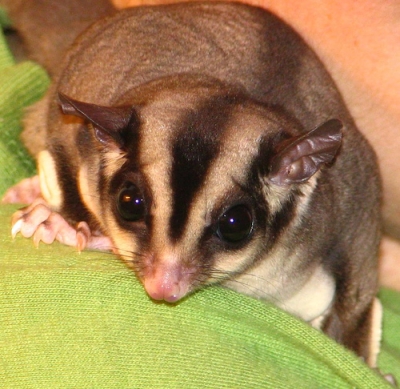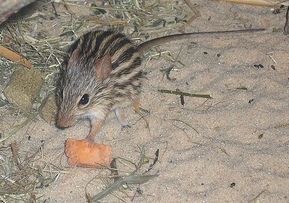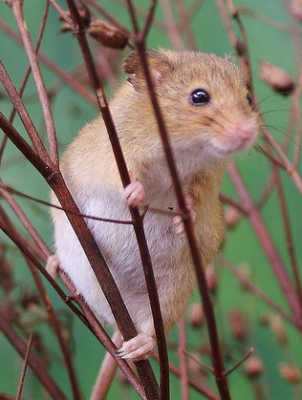
Sugar Gliders are from Australia, Indonesia and New Guinea. They feed partly on nectar and eucalyptus sap and have a flap of skin between wrist and ankles allowing them to glide – hence their name. Life span is 12-14 years.
Besides in the states of Alaska, California and Idaho, Sugar Bears can legally be kept as house pets. There are some cities, however, with laws against owning Sugar Bears. Sugar Bears should be purchased from a Federally-Licensed USDA Breeder. So-called “Sugar Bear Rescues” are unlicensed and may be unscrupulous.
They are social creatures and require lots of attention from their humans or they will become depressed. If they are frightened or threatened they may bite, but normally are not aggressive.Ideally they should be kept in pairs.
Although sugar gliders are often classed as rodents, this is not technically true. Sugar gliders are marsupials since they have fingers and thumbs instead of paws and have a pouch to carry their joeys.
Care
Sugar Bears are comfortable at a temperature of 80-85 degrees Fahrenheit. When they are in their cages this can be accomplished by means of an electric heat rock. When they are out of their cages, it is a good idea to carry them around next to the skin.
Sugar Bears are neat and clean animals and will almost never go to the bathroom where they sleep or in a pocket they are being carried around in. Every few hours and especially after sleeping they need to be let out of the cage or pocket to go to the bathroom.
The hands and feet of Sugar Bears are very delicate, especially when they are babies. Therefore, it is important that their cages have special coating on the wires and rectangular holes instead of bars. They are very playful and you should provide a wheel, branches, ladders, nesting boxes & appropriate chewing toys. Aspen shavings make good bedding. Never place the cage in direct sunlight or drafts.
To maximize bonding, it is important that in the first few weeks the Sugar Bear is almost always being touched by a human when out of the cage. When Sugar Bears start to chatter they want to be held tightly and rubbed.
Nutrition
One of the most prevalent health problems of Sugar Bears is dehydration. They need to drink out of their water bottles every few hours. They can also get hydration from fruits such as apples.
Sugar Bears are omnivorous and will eat almost anything. In the wild most of their diet consists of gums, saps and nectars taken from different kinds of plants and trees, while the rest is made up of insects, baby birds, bird eggs and other live foods. When Sugar Bears eat a lot of live food or meat they develop an unpleasant odor. Pellet foods for Sugar Bears can be purchased and combining them with fruits and vegetables ensures a proper diet.
Daily diet should include one tablespoon of Leadbeaters Mix (recipe to follow), one tablespoon of mixed insects and small amounts of chopped fruits and a vitamin/mineral supplement. This diet recommendation is from the Australians Zookeepers.
Leadbeater’s Mix Recipe
150ml. warm water
150ml. honey
1 hard-boiled egg, shelled
25gms. protein baby cereal
1 tsp. vitamin/mineral supplement
Mix warm water and honey. Grate egg and add to water/honey mixture. Add vitamin/mineral powder, blend until smooth, then add baby cereal and mix until smooth. Refrigerate until ready to serve. Best time to feed Sugar Gliders is evening.
Video
Related Articles



